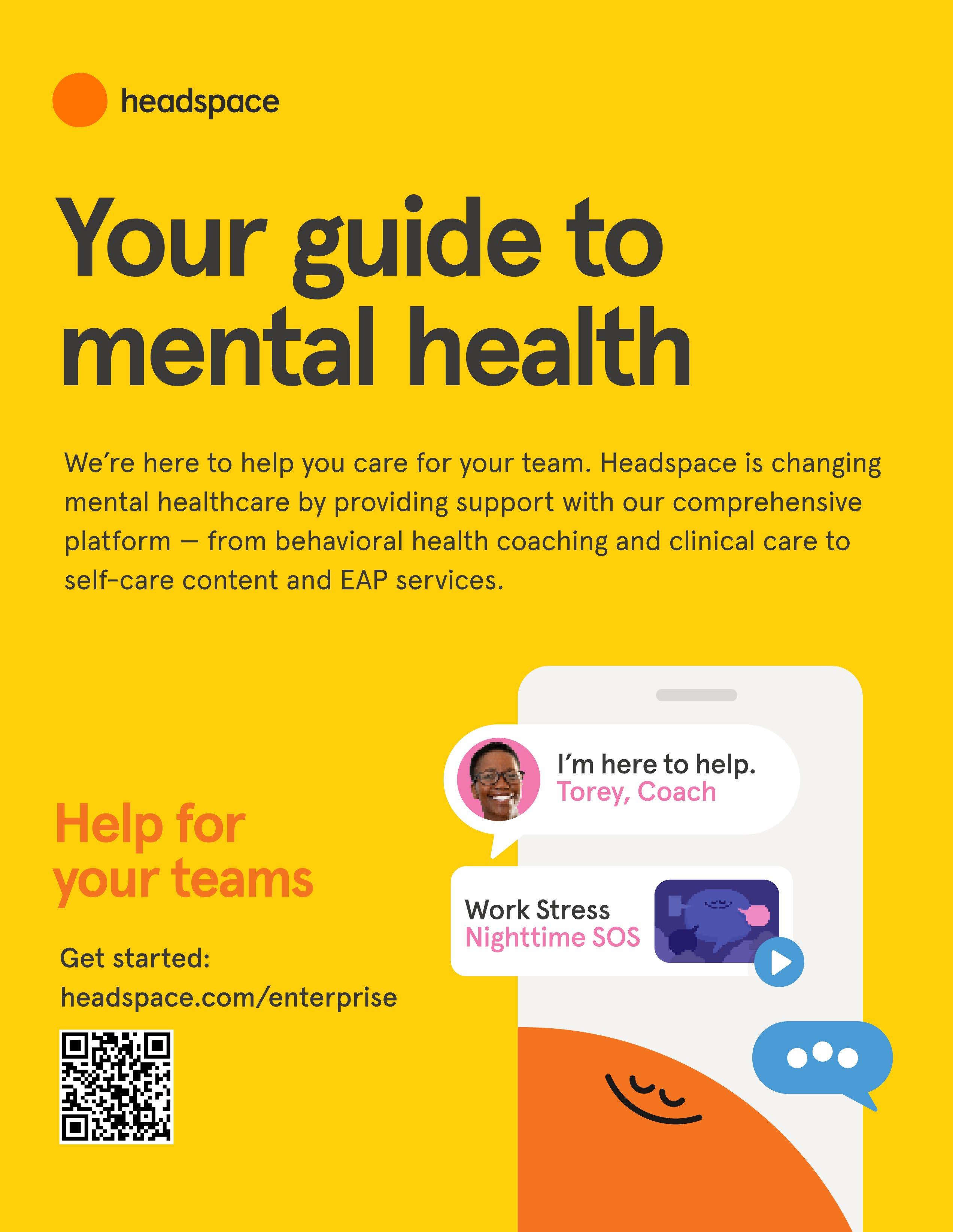
3 minute read
The ROI of Employee Mindfulness and Mental Health Programs
Russell Glass, Headspace
The modern workplace has shifted significantly, creating new challenges for employees as they work remotely, in a hybrid policy, or full-time in the office. Burnout has become more prevalent as employees face increased workloads, a lack of staff, and a diminished work-life balance.
Advertisement
Investing in mental health is beneficial and necessary for employees as well as employers. According to the National Safety Council and NORC at the University of Chicago, employers spend an average of more than $15,000 annually on each employee experiencing mental health issues. This cost stems from days of work missed, employee turnover and replacement costs, and greater healthcare use by workers and family members.1
At a time when employers are facing a tight labor market and budget cuts, implementing a mental health and mindfulness program can be a game-changer. When employees have the tools to improve their well-being, employers have the potential to benefit from increased engagement and productivity, less absenteeism, a higher level of job satisfaction, and improved employee retention.
How Can Employers Support the Mental Well-being of Their Employees?
To guarantee that employers are supporting each employee at every level of mental health need, it’s important that mental well-being offerings are easily accessible and comprehensive. Headspace offers mindfulness and meditation tools rooted in science, combined with behavioral health coaching, therapy, and psychiatry.
Headspace provides companies with end-to-end mental health support for their employees, ensuring they have the resources to improve their everyday wellbeing and access personalized, one-on-one care when needed. A multi-level, collaborative care model makes sure that employees are using higher-cost care only when clinically appropriate, and that they’re supported at every step of their mental health journey.
Proving the Value of Mindfulness and Mental Healthcare
56% of employers want to do more to improve staff well-being, but they don’t feel they have the right training or guidance to make it a reality.2 How can employers ensure that the mental health benefits they offer to their employees are driving value, both for employee well-being and for the company’s bottom line? With data-driven, science-backed solutions with proven ROI.
Mindfulness has been proven to help employees feel more present and engaged at work. It doesn’t take long for employees to see improvements to their mental well-being while engaging in meditation and mindfulness practice using the Headspace app:

● 14% increase in focus after 1 session
● 32% less stress within 30 days of Headspace
● 29% decrease in depressive symptoms within 8 weeks of Headspace
● 19% decrease in anxiety symptoms within 8 weeks of Headspace
And, when science-back meditation is partnered with comprehensive, quality mental healthcare, employees see the benefits. Through our research, we’ve found that when employers implement Ginger’s on-demand mental health system, they see significant outcome improvements for their employees, including:
● 59% of members showing improvement in anxiety symptoms at follow-up3
● 70% of members showing improvement in depression symptoms at follow-up4
● An average increase of 3 healthy mental health days, per employee, per month, after one month of Ginger
What’s more, Headspace recently developed a real-world cost impact model with Accorded (formerly Cerebrae), an actuarial consulting firm, in order to reliably infer how much an employer can expect to save by implementing the Ginger solution for their employee population. Applying the model to a sample engaged population5 , an employer can expect between $101,000 –$302,000 in savings per 100 engaged employees by implementing the Ginger care model, in comparison to the amount they would spend implementing a traditional care model.6
How Mental Well-being Support Makes the Difference
When employers support their employees’ mental well-being with comprehensive tools that meet employees where they are, both individuals and businesses see the benefits, including improved engagement, productivity, and reduced absenteeism. At a time when employees are seeking more support from their employers, mental well-being solutions can be a tool to build happier, healthier, more resilient teams.
If you’re interested in learning about how a comprehensive mental well-being offering can benefit your organization, contact Headspace here
Notes
1 National Safety Council, 2021. “New Mental Health Cost Calculator Shows Why Investing in Mental Health is Good for Business.”
2 Mind. Taking care of your staff. (2022). https://www. mind.org.uk/workplace/mental-health-at-work/ taking-care-of-your-staff/
3 Follow-up in this study was between 6-16 weeks
4 Follow-up in this study was between 6-16 weeks
5 McKinsey & Company, 2021. “Using digital tech to support employees’ mental health and resilience.”
6 Headspace 2022. “The Value of the Ginger System.”
Russell Glass is the CEO of Headspace Health, where he leads the company with his experience as a technology entrepreneur and a passion for digital mental health, strategy, and building great cultures. Most recently, Russ was CEO of Ginger, which merged with Headspace in October 2021 to create Headspace Health.
Would you like to comment?













